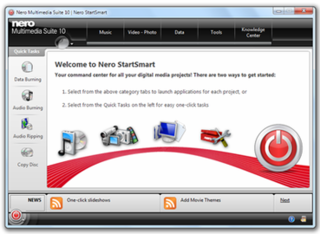Related Research Articles

An optical disc is a flat, usually disc-shaped object that stores information in the form of physical variations on its surface that can be read with the aid of a beam of light. Optical discs can be reflective, where the light source and detector are on the same side of the disc, or transmissive, where light shines through the disc to be detected on the other side.

In computing, an optical disc drive is a disc drive that uses laser light or electromagnetic waves within or near the visible light spectrum as part of the process of reading or writing data to or from optical discs. Some drives can only read from certain discs, but recent drives can both read and record, also called burners or writers. Compact discs, DVDs, and Blu-ray discs are common types of optical media which can be read and recorded by such drives.

Nero Platinum Suite is a software suite for Microsoft Windows that is developed and marketed by Nero AG. Version 2017 of this product was released in October 2016.
Optical disc authoring, including CD, DVD, and Blu-ray Disc authoring, is the process of assembling source material—video, audio or other data—into the proper logical volume format to then be recorded ("burned") onto an optical disc. This act is sometimes done illegally, by pirating copyrighted material without permission from the original artists.
DVD-RAM is a DVD-based disc specification presented in 1996 by the DVD Forum, which specifies rewritable DVD-RAM media and the appropriate DVD writers. DVD-RAM media have been used in computers as well as camcorders and personal video recorders since 1998.
A DVD recorder is an optical disc recorder that uses optical disc recording technologies to digitally record analog or digital signals onto blank writable DVD media. Such devices are available as either installable drives for computers or as standalone components for use in television studios or home theater systems.

The Blu-ray Disc Association (BDA) is the industry consortium that develops and licenses Blu-ray Disc technology and is responsible for establishing format standards and promoting business opportunities for Blu-ray Disc. The BDA is divided into three levels of membership: the board of directors, contributors, and general members.
DVD formats describe the physical properties of the optical disc and how data is stored and manipulated on the disc. The formats are varied according to use, with the largest differences being whether or not the disc is written to. Within each use category, there are often competing formats or implementations.

DVD recordable and DVD rewritable are optical disc recording technologies. Both terms describe DVD optical discs that can be written to by a DVD recorder, whereas only 'rewritable' discs are able to erase and rewrite data. Data is written ('burned') to the disc by a laser, rather than the data being 'pressed' onto the disc during manufacture, like a DVD-ROM. Pressing is used in mass production, primarily for the distribution of home video.
Optical disc authoring requires a number of different optical disc recorder technologies working in tandem, from the optical disc media to the firmware to the control electronics of the optical disc drive.
AVCHD is a file-based format for the digital recording and playback of high-definition video. It is H.264 and Dolby AC-3 packaged into the MPEG transport stream, with a set of constraints designed around the camcorders.
The DVD+VR standard defines a logical format for DVD-Video compliant recording on optical discs. It is intended to be used on DVD+R and DVD+RW media. Most DVD video recorders in the market that support these two types of media also use the DVD+VR format for recording video on them. It is possible to use the DVD+VR format with DVD-R and DVD-RW discs and some recorders exist which do this. The versatility of such recorders is usually limited to eliminate the need for the recorder to store large amounts of video as the disc is rewritten.
The DVD-VR standard defines a logical format for video recording on DVD-R, DVD-RW, and DVD-RAM style media, including the dual layer versions of these media. As opposed to media recorded with the DVD+VR recording standard, the resulting media are not DVD-Video compliant, and do not play back in some DVD-Video players. Most DVD video recorders in the market that support DVD-R, DVD-RW, or DVD-RAM media record to these media in DVD-VR mode, as well as in a DVD-Video compliant mode. It is possible to use the DVD-VR format with DVD+R and DVD+RW media, but no examples are known other than some PC based recording utilities.

The DVD is a digital optical disc data storage format. It was invented and developed in 1995 and first released on November 1, 1996, in Japan. The medium can store any kind of digital data and has been widely used for video programs or formerly for storing software and other computer files as well. DVDs offer significantly higher storage capacity than compact discs (CD) while having the same dimensions. A standard single-layer DVD can store up to 4.7 GB of data, a dual-layer DVD up to 8.5 GB. Variants can store up to a maximum of 17.08 GB.

Blu-ray is a digital optical disc data storage format designed to supersede the DVD format. It was invented and developed in 2005 and released worldwide on June 20, 2006, capable of storing several hours of high-definition video. The main application of Blu-ray is as a medium for video material such as feature films and for the physical distribution of video games for the PlayStation 3, PlayStation 4, PlayStation 5, Xbox One, and Xbox Series X. The name refers to the blue laser used to read the disc, which allows information to be stored at a greater density than is possible with the longer-wavelength red laser used for DVDs.
As of 2021, multiple consumer-oriented, optical-disk media formats are or were available:

Nero Video is a video editing software from Nero AG that provides simple editing functions as well as advanced video editing, which includes multitrack timeline and key framing functions. Nero Video also provides a wide range of functions for including photos and music in video projects, as well as a broad selection of transition, video, audio and title effects. In addition, it includes templates for semi-automatic film creation and for picture-in-picture effects. Once editing is complete, users can export their finished film as a file or upload it to the web. They can also use Nero Video to burn the film onto DVDs and Blu-rays and personalize the discs’ menu and chapters step by step. Video disc creation is a separate module and can be executed directly from the start screen. That enables users to complete their disc-only projects quickly and easily. This authoring module also includes simple cropping and arranging tools.
The Image Mastering Application Programming Interface, or IMAPI, is a component of Microsoft Windows operating system used for CD and DVD authoring and recording.

DVD-Video is a consumer video format used to store digital video on DVD discs. DVD-Video was the dominant consumer home video format in Asia, North America, Europe, and Australia in the 2000s until it was supplanted by the high-definition Blu-ray Disc. Discs using the DVD-Video specification require a DVD drive and an MPEG-2 decoder. Commercial DVD movies are encoded using a combination of MPEG-2 compressed video and audio of varying formats. Typically, the data rate for DVD movies ranges from 3 to 9.5 Mbit/s, and the bit rate is usually adaptive. DVD-Video was first available in Japan on November 1, 1996, followed by a release on March 24, 1997 in the United States—to line up with the 69th Academy Awards that same day.
AVCREC is a format for recording and playback of high definition video in BDAV format using conventional DVD recordable discs as recording media. Presently, AVCREC is tightly integrated with ISDB broadcast standard and is not marketed outside Japan.